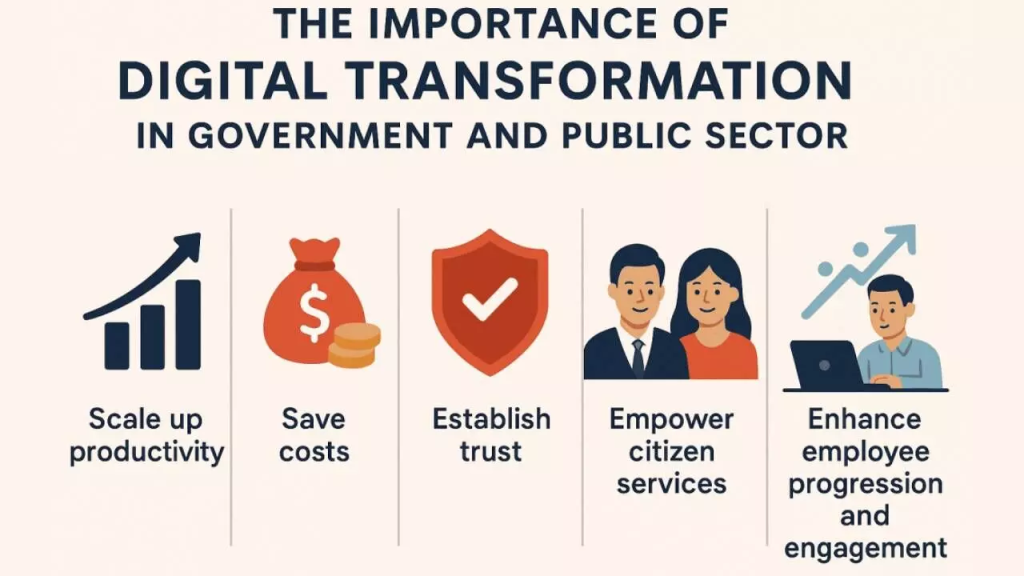Government sites remain analogous to the early internet, slow, disjointed and frustratingly inaccessible. People used to the convenience of Amazon are now exposed to cumbersome portals, old-fashioned forms, and functionality. This loophole is most evident in the case of unclaimed property, where billions of dollars’ worth of property is languishing behind old-fashioned systems. Real digital transformation requires citizen-friendly design, mobile access, and smarter automation in order to transform the responsiveness and efficiency of the public services in the same way the private sector is being transformed.
Digital transformation empowers governments to serve citizens smarter, faster, and more transparently.
Key Takeaways
- Government websites struggle with outdated design, leading to inefficiency and frustration for citizens seeking unclaimed property.
- Digital transformation is essential to improve public services through user-centric design, mobile access, and automation.
- Budget constraints, procurement barriers, and cultural resistance hinder government digital innovation and the management of unclaimed property.
- Implementing a user needs-driven, mobile-first, and API-first approach can bridge the experience gap between public and private sectors.
- Continuous improvement and sustainable business models are crucial for maintaining digital innovation in government services.
Table of Contents
Understanding the Transformation Gap
Current State of Government Digital Services
Most public websites remain stuck in the past. They’re designed for desktop screens, not phones, and are cluttered with confusing forms that demand data users rarely know. They lack cross-agency search, progress-saving features, or multilingual support. Accessibility for people with disabilities is often poor, and many portals still “close” outside business hours, an absurdity in 2025.
The Experience Gap

The gap between the public and the private digital experiences is amazing. Amazon provides one-time ordering and real-time delivery; the governments need 15-field orders and 6-week delivery. Instant transfers with the help of mobile are permitted in banks, whereas in agencies, one has to visit the agency. Netflix personalizes every recommendation; many government portals still host broken links, PDF downloads, and outdated unclaimed property databases. Citizens expect parity. When everything else in their lives is fast and user-friendly, clunky public systems don’t just frustrate, they erode confidence in public institutions.
Why the Gap Exists
Budget Constraints
Most government IT departments operate on scraps, often 1 -2% of total budgets. Innovation competes with essential services, and maintenance of legacy systems eats what little funding remains. There’s rarely room for research, testing, or user engagement.
Procurement Barriers
Procurement systems move more slowly than technology itself. Requests for proposals can drag on for a year, usually favoring the cheapest bidder rather than the most capable. Once contracts are signed, agencies are locked into aging systems. Even small updates can take months of approvals.
Talent Challenges
The state sector finds it difficult to harness or keep the best technology talent. Salaries are lower, hiring is delayed and regulations are strict. Remote work restrictions shrink the pool further. As digital veterans retire, institutional knowledge fades, leaving dependence to handle issues like unclaimed property on outdated vendors.
Political Reality
Technology projects rarely win elections. Politicians prefer visible projects, such as bridges, schools, or roads, over back-end systems that voters can’t see. Long election cycles discourage long-term tech investments, while fear of public failure keeps leaders risk-averse.
Cultural Resistance
Inside many agencies, “we’ve always done it this way” is the default defense. Departments guard their data, managers lack digital literacy, and unions worry about automation. Change feels threatening rather than empowering, and the unclaimed property sector grows unchecked.
Transformation Framework

Principle 1: Start with User Needs, Not Government Processes
Digitizing a bad process doesn’t make it better; it just digitizes frustration. Transformation begins with empathy: interview real citizens, document their journeys, identify pain points, and eliminate unnecessary steps. Success means users can complete their task easily, not that the agency met an internal milestone.
Principle 2: Mobile-First, Not Desktop-First
More than 60 percent of government traffic is now through mobile devices, and most of the citizens with low income make use of phones alone. Designing for desktop first effectively excludes them. Mobile-first approach implies clarity, reduced number of fields, simplified navigation and reduced load time.
Principle 3: API-First Architecture
Government systems should be built as services, not silos. The API-first approach enables sharing data within departments and third-party innovation. APIs can allow various interfaces, applications, web pages, and chat robots to share a single trusted source of data, which is consistent and can be scaled. They also future-proof systems against interface or vendor changes.
Principle 4: Continuous Improvement, Not Big Bang
Grand launches are the favored methods by the government, whereas the big projects usually fail due to complexity. Agile techniques are more effective: deliver a minimum viable product, gather feedback and repeat. Minor, continuous successes are better than colossal, gradual revolutions. Visible progress builds public trust.
Principle 5: Measure What Matters
Governments often celebrate “activity metrics” like forms digitized or login figures that reveal nothing about user success. The results are what matter: the task is done, more time was saved, the number of mistakes has been decreased, and it has become more accessible. There are such platforms as ClaimNotify, which reflect this change, reshaping unclaimed property systems to reflect the needs of citizens. The mobile-first design, API-based infrastructure, and data-driven iteration they use to measure success by counting actual dollars being paid back to citizens demonstrates that human-centered design is more effective than bureaucracy, even in the most complicated areas of the state.
Principle 6: Sustainable Business Models
Governments rarely sustain digital innovation over time. Civic tech innovators must therefore adopt hybrid models. Public-private partnerships spread cost and risk. Freemium tiers make services accessible while enabling optional paid features. Businesses can pay for API access, allowing citizens to benefit free of charge. Grants and social enterprise structures can bridge funding gaps while maintaining mission integrity.
Implementation Roadmap
Phase 1: Discovery
Start with human research. Interview citizens, identify barriers, and document the current workflow. Determine which quick wins, like simplifying forms or automating status updates, deliver the most impact. Build a coalition across agencies and secure seed funding.
Phase 2: MVP Development
Create a prototype, simple, with mobile capability, which resolves one high-impact problem. Focus on essential capability and quantifiable customer performance. Introduce it to a limited number of people and collect analytics to understand how the people actually use it.
Phase 3: Iteration
Continuously improve the system with the use of data and user feedback. Design aspects of A/B tests, remove friction, and introduce features on the basis of real demand. Open communications ensure that users are entertained and show accountability.
Phase 4: Scale
Prove yourself and then go national or regional. APIs are required to integrate related services, benefits, licensing, and taxation. Request procurement and data-sharing reformation to work together more easily, and publish the code as open source to enable other agencies to emulate success.
Key Success Factors
Adoption of an executive sponsorship, agile, inter-departmental teamwork, and communication. Quick wins provide internal confidence and are worth making bigger investments.
Transformation Lessons Learned
Technology is not the most difficult aspect of digital transformation; it is culture. Code is not the most slackening factor than fear, politics and inertia. Small initial transformations are the beginning of the real change: demonstrate value early, learn, and concentrate on citizens, and not bureaucracy. At times when governments fail to move, civic innovators such as ClaimNotify are at the forefront by demonstrating how transparency, data, and design thinking can help to modernize old systems. The change is not an option anymore; it is a civic duty to make sure every citizen enjoys the benefits of getting a public service easily, fairly and in a dignified manner.











